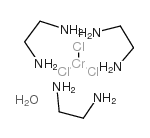tris(ethylenediamine)chromium (iii) chloride
Modify Date: 2024-01-02 12:06:51

tris(ethylenediamine)chromium (iii) chloride structure
|
Common Name | tris(ethylenediamine)chromium (iii) chloride | ||
|---|---|---|---|---|
| CAS Number | 16165-32-5 | Molecular Weight | 356.66500 | |
| Density | N/A | Boiling Point | 119.7ºC at 760 mmHg | |
| Molecular Formula | C6H26Cl3CrN6O | Melting Point | N/A | |
| MSDS | N/A | Flash Point | 33.9ºC | |
| Name | tris(ethylenediamine)chromium (iii) chloride |
|---|---|
| Synonym | More Synonyms |
| Boiling Point | 119.7ºC at 760 mmHg |
|---|---|
| Molecular Formula | C6H26Cl3CrN6O |
| Molecular Weight | 356.66500 |
| Flash Point | 33.9ºC |
| Exact Mass | 355.06400 |
| PSA | 165.35000 |
| LogP | 2.91740 |
|
Section 1: Product Identification Chemical Name:Tris(ethylenediamine)chromium(III) chloride hemiheptahydrate, min. 98% CAS Registry Number:16165-32-5 Formula:Cr(H2NCH2CH2NH2)3Cl3.3.5H2O EINECS Number:none Chemical Family:metal-ammine complexes Synonym:Chromium trichloride, tris(ethylenediamine) hemiheptahydrate complex.
Section 2: Composition and Information on Ingredients IngredientCAS NumberPercentACGIH (TWA)OSHA (PEL) Title Compound16165-32-5100%0.5mg/m3 (as Cr)0.5mg/m3 (as Cr) Section 3: Hazards Identification Emergency Overview:Irritating to the respiratory tract, skin and eyes. May be harmful if swallowed. Primary Routes of Exposure:Ingestion, inhalation Eye Contact:Causes slight to mild irritation of the eyes. Skin Contact:Causes slight to mild irritation of the skin. Inhalation:Irritating to skin, eyes and respiratory tract. Ingestion:No information is available on the physiological effects of ingestion. Acute Health Affects:Irritating to skin, eyes and respiratory tract. Although less toxic than Chromium (VI), some animal studies show chromium (III) chloride to act as a Chronic Health Affects: mutagen and reproductive effector. NTP:yes IARC:No OSHA:No SECTION 4: First Aid Measures Immediately flush the eyes with copious amounts of water for at least 10-15 minutes. A victim may need Eye Exposure: assistance in keeping their eye lids open. Get immediate medical attention. Wash the affected area with water. Remove contaminated clothes if necessary. Seek medical assistance if Skin Exposure: irritation persists. Remove the victim to fresh air. Closely monitor the victim for signs of respiratory problems, such as difficulty Inhalation: in breathing, coughing, wheezing, or pain. In such cases seek immediate medical assistance. Seek medical attention immediately. Keep the victim calm. Give the victim water (only if conscious). Induce Ingestion: vomiting only if directed by medical personnel. SECTION 5: Fire Fighting Measures Flash Point:not applicable Autoignition Temperature:no data Explosion Limits:no data Extinguishing Medium:Water, carbon dioxide, dry powder or foam. If involved in a fire, fire fighters should be equipped with a NIOSH approved positive pressure self-contained Special Fire Fighting Procedures: breathing apparatus and full protective clothing. Hazardous Combustion andIf involved in a fire this material may emit fumes containing toxic chromium compounds Decomposion Products: Unusual Fire or Explosion Hazards: No unusual fire or explosion hazards. SECTION 6: Accidental Release Measures Small spills may be adsorbed into diatomaceous earth, sand, vermiculite or other suitable adsorbent powder, Spill and Leak Procedures: and swept up. SECTION 7: Handling and Storage Handling and Storage:Store material in a tightly sealed container. SECTION 8: Exposure Controls and Personal Protection Eye Protection:Always wear approved safety glasses when handling a chemical substance in the laboratory. Skin Protection:Wear appropriate chemical resistant gloves and protective clothing. Ventilation:Material may form a fine dust. If possible, handle the material in an efficient fume hood. In the absence of adequate ventilation a respirator should be worn. The use of a respiratory requires a Respirator: Respirator Protection Program to be in compliance with 29 CFR 1910.134. Ventilation:Material may form a fine dust. If possible, handle the material in an efficient fume hood. Additional Protection:No additional protection required. SECTION 9: Physical and Chemical Properties Color and Form:yellow pwdr. Molecular Weight:338.65 (401.71) Melting Point:no data Boiling Point:no data Vapor Pressure:no data Specific Gravity:no data Odor:none Solubility in Water:soluble SECTION 10: Stability and Reactivity Stability:air and moisture stable Hazardous Polymerization:no hazardous polymerization Conditions to Avoid:mixing with strong acids Incompatibility:strong oxidizing agents Decomposition Products:Carbon dioxide, carbon monoxide, nitrogen, nitrogen oxides, water vapor, and chromium (III) chloride SECTION 11: Toxicological Information RTECS Data:No specific information available on this product. Carcinogenic Effects:No data available Mutagenic Effects:No data available Tetratogenic Effects:No data available SECTION 12: Ecological Information Ecological Information:No information available SECTION 13: Disposal Considerations Disposal:Dispose of according to local, state and federal regulations. SECTION 14: Transportation Shipping Name (CFR):Non-hazardous Hazard Class (CFR):NA Additional Hazard Class (CFR):NA Packaging Group (CFR):NA UN ID Number (CFR):NA Shipping Name (IATA):Non-hazardous Hazard Class (IATA):NA Additional Hazard Class (IATA):NA Packaging Group (IATA):NA UN ID Number (IATA):NA SECTION 15: Regulatory Information TSCA:Not listed in the TSCA inventory. SARA (Title 313):Title compound see Category Code N090 for reporting. Second Ingredient:none SECTION 16 - ADDITIONAL INFORMATION N/A |
| chromium ethylene diamine chloride |
| MFCD00150160 |